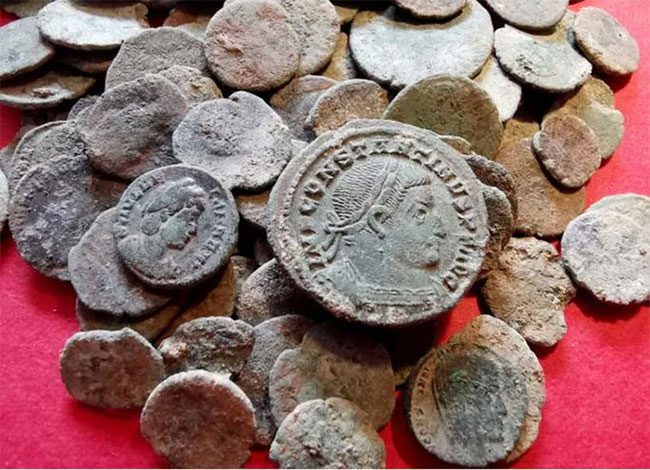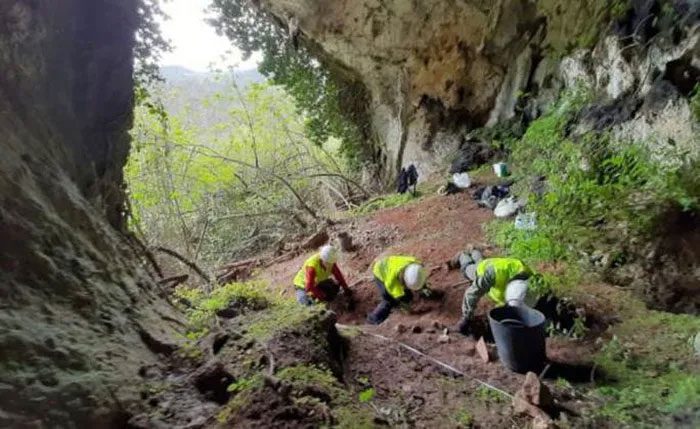You may be familiar with the Nifflers from the Harry Potter universe, a mythical creature resembling a badger with sleek black fur and a duckbill. This creature is known for its fondness for shiny objects—especially coins. Here’s a real-life version of it:
A honey badger is believed to have burrowed into the La Cuesta Cave in Asturias, northern Spain, and unearthed a treasure trove containing over 200 ancient Roman coins. “When we arrived, we discovered a hole leading to the badger’s den, and the ground around it was filled with coins,” said archaeologist Dr. Alfonso Fanjul Peraza.

200 ancient Roman coins.
These coins date back to approximately 200-400 AD and originate from across Europe. Some were minted in London, Lyon, Arles (France), Thessalonica (Greece), Constantinople (the ancient capital of Rome), and Antioch (an ancient city located in present-day Turkey).
In 219 BC, Roman forces began their conquest of the Iberian Peninsula, which encompasses modern-day Spain and Portugal. They overthrew the Carthaginians here and gradually conquered all the tribes on the peninsula. However, it took more than 200 years for the powerful Roman Empire to fully subjugate Iberia.
Afterward, they ruled the region for 500 years until groups such as the Sueves, Vandals, and Visigoths began to challenge the Empire’s control. Around 409 AD, a Germanic tribe known as the Suebi started invading the peninsula and pushing back the Romans.
Dr. Peraza suggests that this may have been the time when these coins were buried. Refugees may have sought shelter in the La Cuesta Cave and decided to bury their valuables before fleeing.
“We believe this treasure reflects a period of social and political instability in Rome, coinciding with the Empire’s collapse due to the uprisings of barbarian tribal groups in northern Spain,” Dr. Peraza stated.
A second hypothesis is that La Cuesta may have served as a sort of reserve. It could have been a place where people could deposit and withdraw money. Archaeologists suggest that such caves might have acted as a form of ancient bank account.

Archaeologists working in the cave.
Published in the Journal of Prehistory and Archaeology, the archaeologists noted that most of the coins they found were made of copper, with some mixed with silver. These were of lower denominations compared to the 14 gold coins discovered at a nearby site known as the “Chapipi Treasure” in 1930. These gold coins also date back to the same Roman era as the newly found coins.
One of the largest coins in the badger’s treasure weighs over 8 grams and contains 4% silver. Archaeologists identified it as having been minted in London. With a total of 209 coins found by the badger, this is now recognized as the largest collection of ancient coins ever discovered in northern Spain.
However, archaeologists suspect that this may only be a part of an even larger treasure that has been removed. The remaining copper coins seem to be the least valuable items left behind.
As for the badger, it is unclear whether these coins would have helped adorn its home. But according to the archaeologists, the badger might not have cared much about them.
Badgers typically enter caves in search of food rather than coins. Or it may have simply dug this cave to escape the harsh winter. The badger’s den appears to have been excavated last January during the Filomena snowstorm that swept through Spain, dumping a record amount of snow.
By the time Dr. Peraza and his archaeological team arrived at La Cuesta Cave and collected all the coins, the badger was no longer there. They excavated the badger’s treasure and took the coins to the Archaeological Museum of Asturias.
The archaeologists also plan to return to the cave to continue searching for any remaining clues. They believe that La Cuesta Cave may still hold many valuable artifacts that could help historians learn more about the collapse of the Roman Empire and the subsequent formation of medieval kingdoms in northern Spain.
As for the badger, it surely won’t be pleased. It might be very upset to return home and find its dwelling dug up and its treasure gone.




















































